Operationalizing Community Engagement for Positive Energy Districts: A Dual-Tier Framework and Case-Validated Roadmaps
Abstract
1. Introduction
1.1. Context and Objectives
1.2. Related Works and Previous Contributions in Positive Energy Districts (PEDs)
2. Methodology
2.1. Theory-of-Change (ToC) and Lifecycle Alignment
2.2. Stakeholder Mapping and Analysis
2.3. Roadmap Development Process
2.4. Assessment Framework: Positive Energy District (PED) Matrix
2.4.1. Purpose and Scope of the PED Matrix
2.4.2. Eight Dimensions and the 0–3 Maturity Scale
2.4.3. Need for Four Levels of Citizen and Stakeholder Participation in Energy Transition Projects
2.4.4. Quadruple Helix (QH) Across Lifecycle Phases
2.5. Implementation Approaches in PED Development (Roadmap Archetypes)
2.5.1. Bottom-up PED Development
2.5.2. Top-down PED Implementation
2.5.3. Technical and/or Innovation PED Approach
2.6. Case Selection and Data
3. Results: Case Applications
3.1. Bottom-Up Case: Austrian Renewable Energy Community
3.2. Top-Down Case: Swedish Municipal Leadership
3.3. Private Sector Case: Spanish Industrial Renewable Energy Community
3.4. Walkthrough of the Three Illustrative Cases
4. Discussion and Suggestions
4.1. Key Findings
4.2. Limitations
4.3. Sustaining Long-Term Engagement
- Clear roles:
- Define meaningful responsibilities aligned with citizen interests and capacities.
- Provide skill development opportunities.
- Implement recognition systems.
- Establish succession planning to ensure institutional memory.
- Clear voice:
- Grant authentic decision-making authority.
- Maintain accessible and transparent communication channels.
- Institute formal conflict resolution mechanisms to validate participant input.
- Clear rewards:
4.4. Linking the Assessment Framework (PED Matrix) to an Iterative Engagement Process
5. Conclusions
5.1. Policy Recommendations
5.1.1. For Project Developers
5.1.2. For Communities
5.1.3. For Policymakers
5.2. Guide for Key Stakeholders
5.2.1. Advocacy of Citizens and Civil Society
5.2.2. Private Sector Engagement
5.2.3. Public Sector Leadership
Author Contributions
Funding
Data Availability Statement
Acknowledgments
Conflicts of Interest
References
- IEA. Perspectives for the Clean Energy Transition—Analysis. Available online: https://www.iea.org/reports/the-critical-role-of-buildings (accessed on 16 September 2025).
- Bossi, S.; Gollner, C.; Theierling, S. Towards 100 Positive Energy Districts in Europe: Preliminary Data Analysis of 61 European Cases. Energies 2020, 13, 6083. [Google Scholar] [CrossRef]
- Ahlers, D.; Driscoll, P.; Wibe, H.; Wyckmans, A. Co-Creation of Positive Energy Blocks. IOP Conf. Ser. Earth Environ. Sci. 2019, 352, 012060. [Google Scholar] [CrossRef]
- JPI Urban Europe (Ed.) Booklet of Positive Energy Districts in Europe: A Compilation of Projects Towards Sustainable Urbanization and the Energy Transition. 2019. Available online: https://jpi-urbaneurope.eu/wp-content/uploads/2019/04/Booklet-of-PEDs_JPI-UE_v5_NO-ADD.pdf (accessed on 19 September 2025).
- Zhang, X.; Penaka, S.R.; Giriraj, S.; Sánchez, M.N.; Civiero, P.; Vandevyvere, H. Characterizing Positive Energy District (PED) through a Preliminary Review of 60 Existing Projects in Europe. Buildings 2021, 11, 318. [Google Scholar] [CrossRef]
- Sareen, S.; Albert-Seifried, V.; Aelenei, L.; Reda, F.; Etminan, G.; Andreucci, M.-B.; Kuzmic, M.; Maas, N.; Seco, O.; Civiero, P.; et al. Ten questions concerning positive energy districts. Build. Environ. 2022, 216, 109017. [Google Scholar] [CrossRef]
- Ornetzeder, M. Positive Energy Districts (ITA Dossier No.73en, Dec. 2023); Austrian Academy of Sciences: Viena, Austria, 2024. [Google Scholar] [CrossRef]
- Nair, G.; Mattsson, M.; Delice, E.; Dino, I.G.; Production, E. Efficiency and Flexibility for Positive Energy Districts: A Review. In Proceedings of the 3rd International Sustainable Energy Conference, Graz, Austria, 10–11 April 2024; Volume 1. [Google Scholar] [CrossRef]
- Neumann, H.-M.; Hainoun, A.; Stollnberger, R.; Etminan, G.; Schaffler, V. Analysis and Evaluation of the Feasibility of Positive Energy Districts in Selected Urban Typologies in Vienna Using a Bottom-Up District Energy Modelling Approach. Energies 2021, 14, 4449. [Google Scholar] [CrossRef]
- Hearn, A.X. Positive energy district stakeholder perceptions and measures for energy vulnerability mitigation. Appl. Energy 2022, 322, 119477. [Google Scholar] [CrossRef]
- Mihailova, D.; Schubert, I.; Martinez-Cruz, A.L.; Hearn, A.X.; Sohre, A. Preferences for configurations of Positive Energy Districts—Insights from a discrete choice experiment on Swiss households. Energy Policy 2022, 163, 112824. [Google Scholar] [CrossRef]
- Hearn, A.X.; Castaño-Rosa, R. Towards a Just Energy Transition, Barriers and Opportunities for Positive Energy District Creation in Spain. Sustainability 2021, 13, 8698. [Google Scholar] [CrossRef]
- Baer, D.; Loewen, B.; Cheng, C.; Thomsen, J.; Wyckmans, A.; Temeljotov-Salaj, A.; Ahlers, D. Approaches to Social Innovation in Positive Energy Districts (PEDs)—A Comparison of Norwegian Projects. Sustainability 2021, 13, 7362. [Google Scholar] [CrossRef]
- Corsini, F.; Certomà, C.; Dyer, M.; Frey, M. Participatory energy: Research, imaginaries and practices on people’ contribute to energy systems in the smart city. Technol. Forecast. Soc. Change 2019, 142, 322–332. [Google Scholar] [CrossRef]
- Nguyen, M.-T.; Batel, S. A Critical Framework to Develop Human-Centric Positive Energy Districts: Towards Justice, Inclusion, and Well-Being. Front. Sustain. Cities 2021, 3, 691236. [Google Scholar] [CrossRef]
- Olivadese, R.; Alpagut, B.; Revilla, B.P.; Brouwer, J.; Georgiadou, V.; Woestenburg, A.; Van Wees, M. Towards Energy Citizenship for a Just and Inclusive Transition: Lessons Learned on Collaborative Approach of Positive Energy Districts from the EU Horizon2020 Smart Cities and Communities Projects. In Proceedings of the 8th Annual International Sustainable Places Conference (SP2020), Virtual, 27–30 October 2020. [Google Scholar]
- Sassenou, L.-N.; Olivieri, L.; Olivieri, F. Challenges for positive energy districts deployment: A systematic review. Renew. Sustain. Energy Rev. 2024, 191, 114152. [Google Scholar] [CrossRef]
- Krangsås, S.G.; Steemers, K.; Konstantinou, T.; Soutullo, S.; Liu, M.; Giancola, E.; Prebreza, B.; Ashrafian, T.; Murauskaitė, L.; Maas, N. Positive Energy Districts: Identifying Challenges and Interdependencies. Sustainability 2021, 13, 10551. [Google Scholar] [CrossRef]
- Turci, G.; Civiero, P.; Aparisi-Cerdá, I.; Marotta, I.; Massa, G. Transition Approaches towards Positive Energy Districts: A Systematic Review. Buildings 2024, 14, 3039. [Google Scholar] [CrossRef]
- Trulsrud, T.H.; van der Leer, J. Towards a positive energy balance: A comparative analysis of the planning and design of four positive energy districts and neighbourhoods in Norway and Sweden. Energy Build. 2024, 318, 114429. [Google Scholar] [CrossRef]
- Ishola, A.O.; Odunaiya, O.G.; Soyombo, O.T. Stakeholder communication framework for successful implementation of community-based renewable energy projects. Int. J. Front. Eng. Technol. Res. 2024, 7, 025–043. [Google Scholar] [CrossRef]
- Trevisan, R.; Ghiani, E.; Pilo, F. Renewable Energy Communities in Positive Energy Districts: A Governance and Realisation Framework in Compliance with the Italian Regulation. Smart Cities 2023, 6, 563–585. [Google Scholar] [CrossRef]
- Gooding, K.; Makwinja, R.; Nyirenda, D.; Vincent, R.; Sambakunsi, R. Using Theories of Change to Design Monitoring and Evaluation of Community Engagement in Research: Experiences from a Research Institute in Malawi. Wellcome Open Res. 2018, 3, 8. [Google Scholar] [CrossRef]
- Muller, G. Applying Roadmapping and Conceptual Modeling to the Energy Transition: A Local Case Study. Sustainability 2021, 13, 3683. [Google Scholar] [CrossRef]
- Mee, A.; Lyes, M.; Crowe, P. Energy Urbanity and Active Citizen Participation. Energies 2021, 14, 6515. [Google Scholar] [CrossRef]
- Bertolami, I.; Bisello, A.; Volpatti, M.; Bottero, M.C. Exploring Multiple Benefits of Urban and Energy Regeneration Projects: A Stakeholder-Centred Methodological Approach. Energies 2024, 17, 2862. [Google Scholar] [CrossRef]
- Brozovsky, J.; Gustavsen, A.; Gaitani, N. Zero emission neighbourhoods and positive energy districts—A state-of-the-art review. Sustain. Cities Soc. 2021, 72, 103013. [Google Scholar] [CrossRef]
- Schütz, F.; Heidingsfelder, M.L.; Schraudner, M. Co-shaping the Future in Quadruple Helix Innovation Systems: Uncovering Public Preferences toward Participatory Research and Innovation. She Ji J. Des. Econ. Innov. 2019, 5, 128–146. [Google Scholar] [CrossRef]
- Starkbaum, J.; Braun, R.; Blok, V.; Schroth, F.; Häußermann, J.J.; Colonnello, C.; Popa, E.; Wesselink, R.; Gerhardus, A. Responsible innovation across societal sectors: A practice perspective on Quadruple Helix collaboration. J. Responsible Innov. 2024, 11, 2414531. [Google Scholar] [CrossRef]
- Nordberg, K.; Mariussen, Å.; Virkkala, S. Community-driven social innovation and quadruple helix coordination in rural development. Case study on LEADER group Aktion Österbotten. J. Rural. Stud. 2020, 79, 157–168. [Google Scholar] [CrossRef]
- Hasche, N.; Höglund, L.; Linton, G. Quadruple helix as a network of relationships: Creating value within a Swedish regional innovation system. J. Small Bus. Entrep. 2020, 32, 523–544. [Google Scholar] [CrossRef]
- Nasya, B.; Vurucu, Y.; Akkaya, B.; Nedkova, D.; Nair, G.; Shah, J.; Han, M.; Zhang, X. Multi-dimensional self-assessment matrix and scoring system for Positive Energy Districts. Frontiers in Sustainable Cities. 2025. Available online: https://www.frontiersin.org/journals/sustainable-cities/articles/10.3389/frsc.2025.1688667/abstract (accessed on 16 September 2025).
- Nasya, B.; Vurucu, Y.; Akkaya, B. PED MANIFESTO: Turning the Balance of Local Energy into Positive; Wonderland—Platform for European Architecture: Viena, Austria, 2024. [Google Scholar]
- Vandevyvere, H.; Ahlers, D.; Wyckmans, A. The Sense and Non-Sense of PEDs—Feeding Back Practical Experiences of Positive Energy District Demonstrators into the European PED Framework Definition Development Process. Energies 2022, 15, 4491. [Google Scholar] [CrossRef]
- Maestosi, P.C.; Salvia, M.; Pietrapertosa, F.; Romagnoli, F.; Pirro, M. Implementation of Positive Energy Districts in European Cities: A Systematic Literature Review to Identify the Effective Integration of the Concept into the Existing Energy Systems. Energies 2024, 17, 707. [Google Scholar] [CrossRef]
- Bürger*innenKRAFTwerk—Wonderland. Available online: https://wonderland.cx/burgerinnenkraftwerk/ (accessed on 31 October 2025).
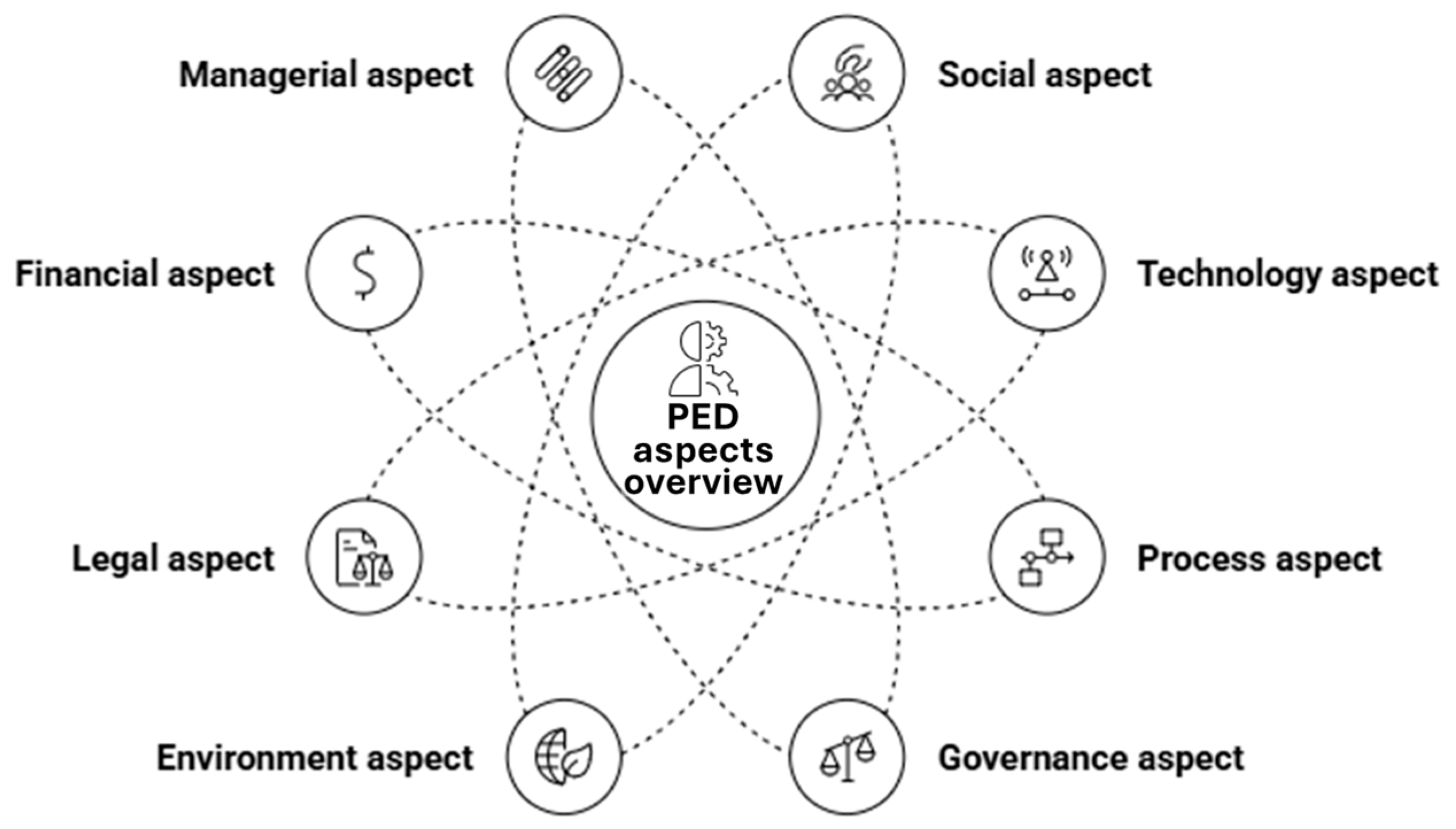
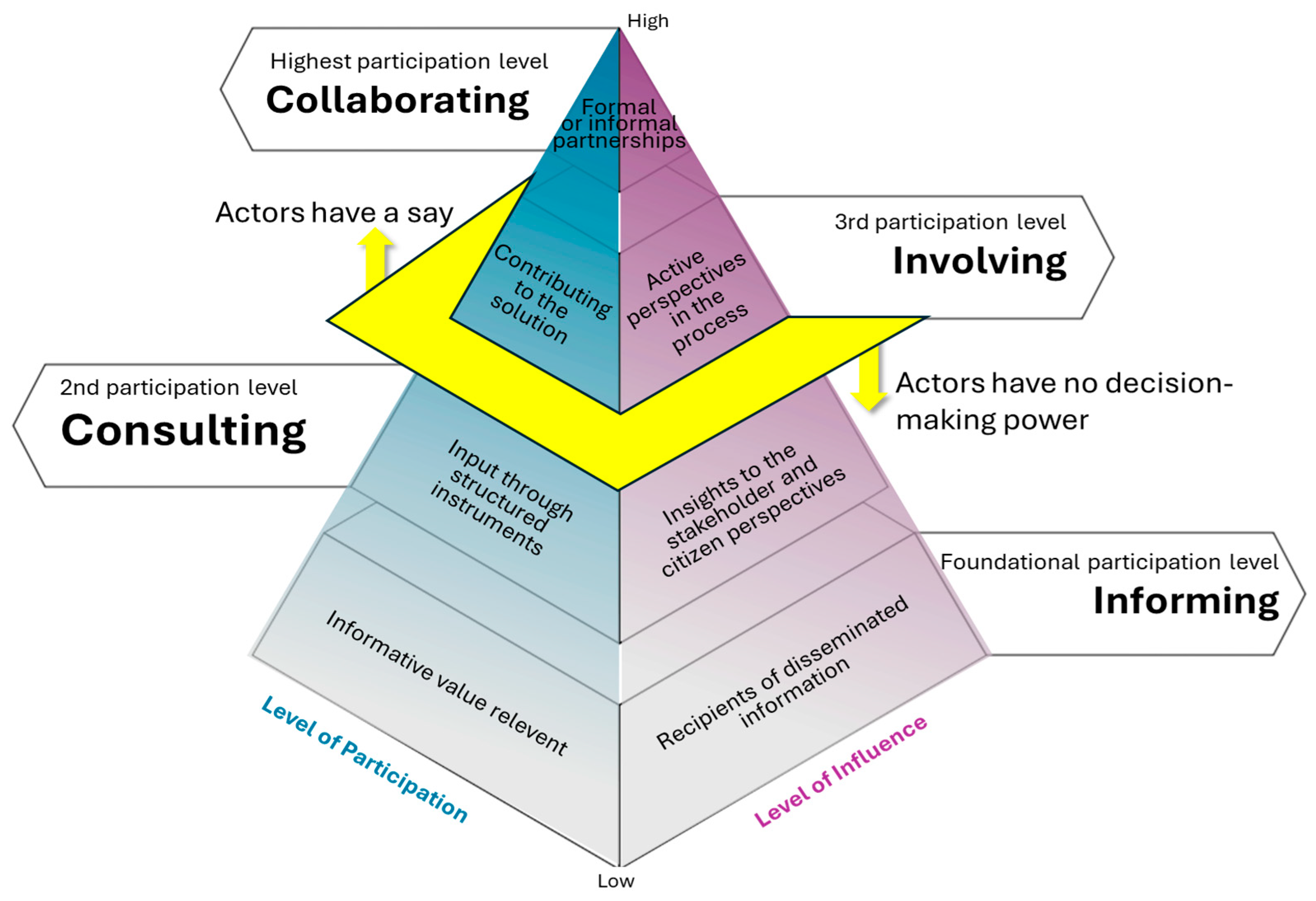
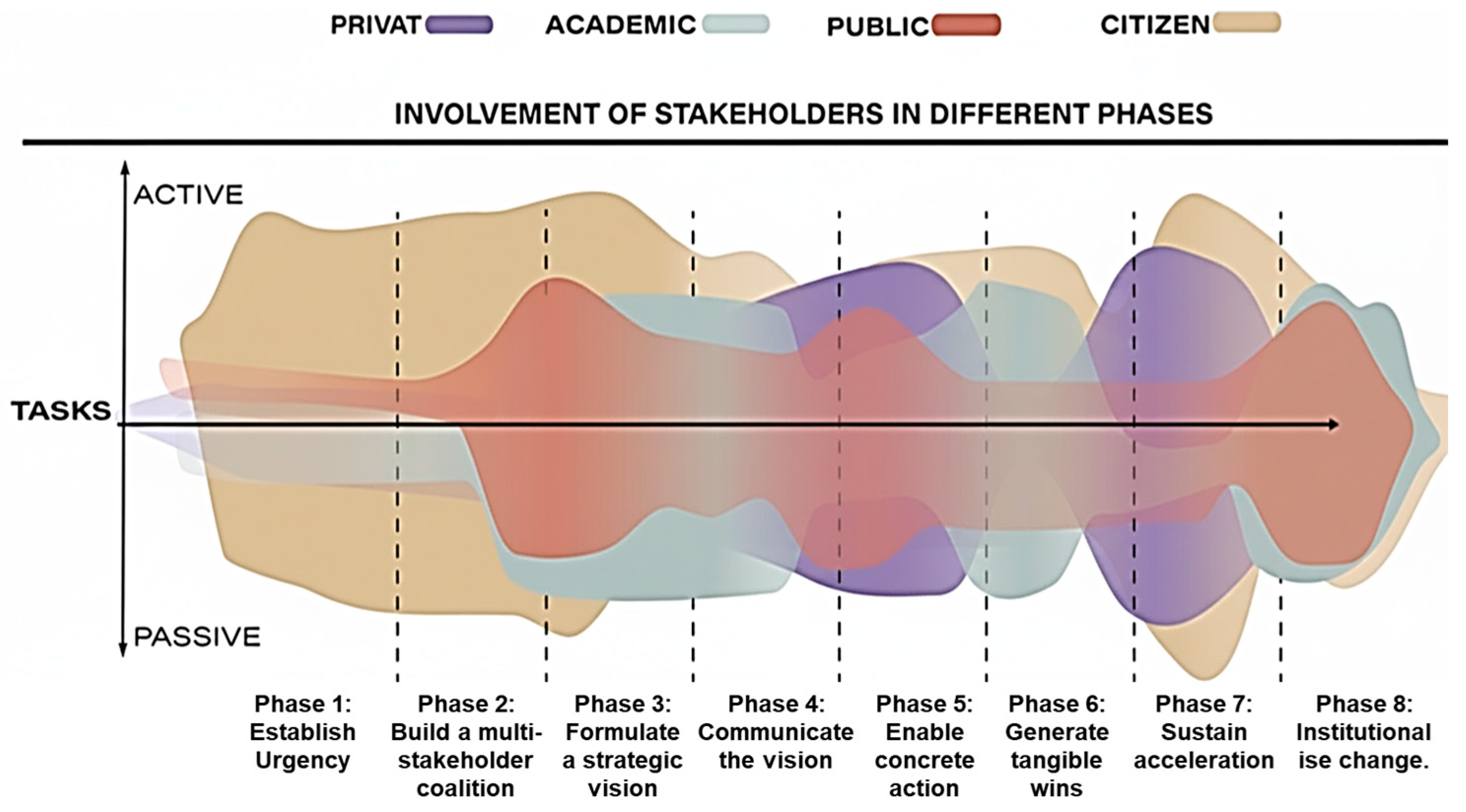

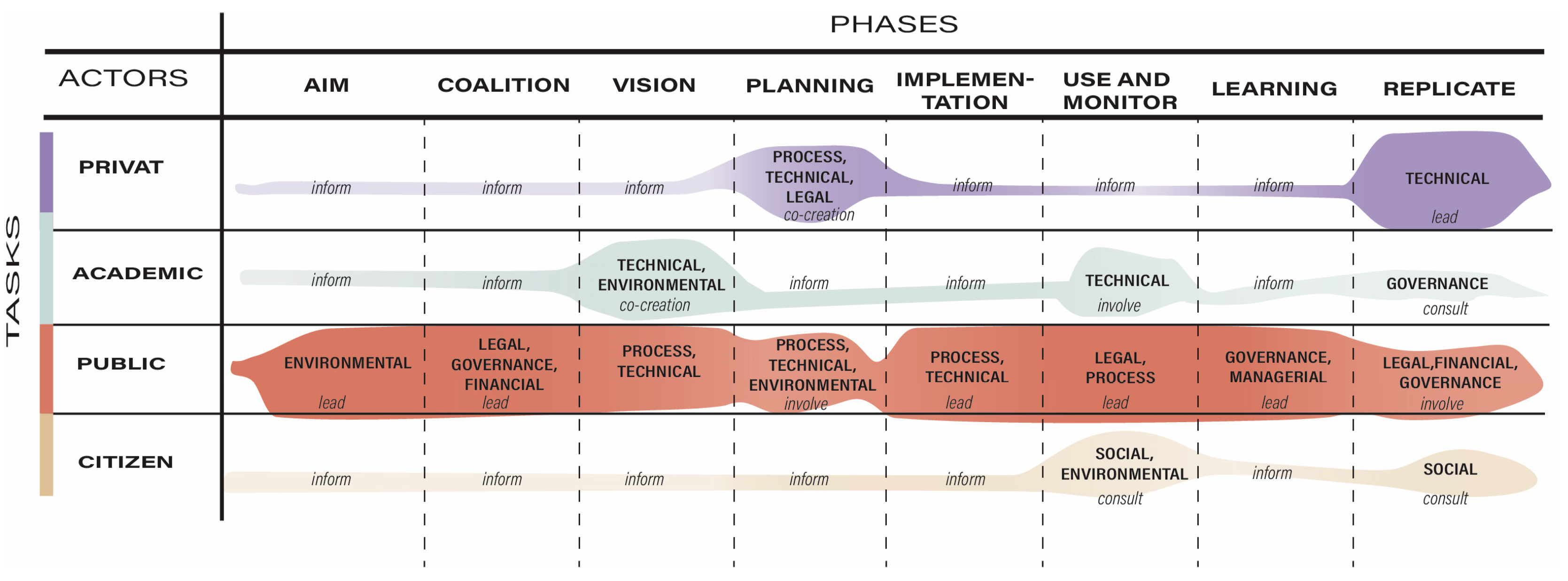
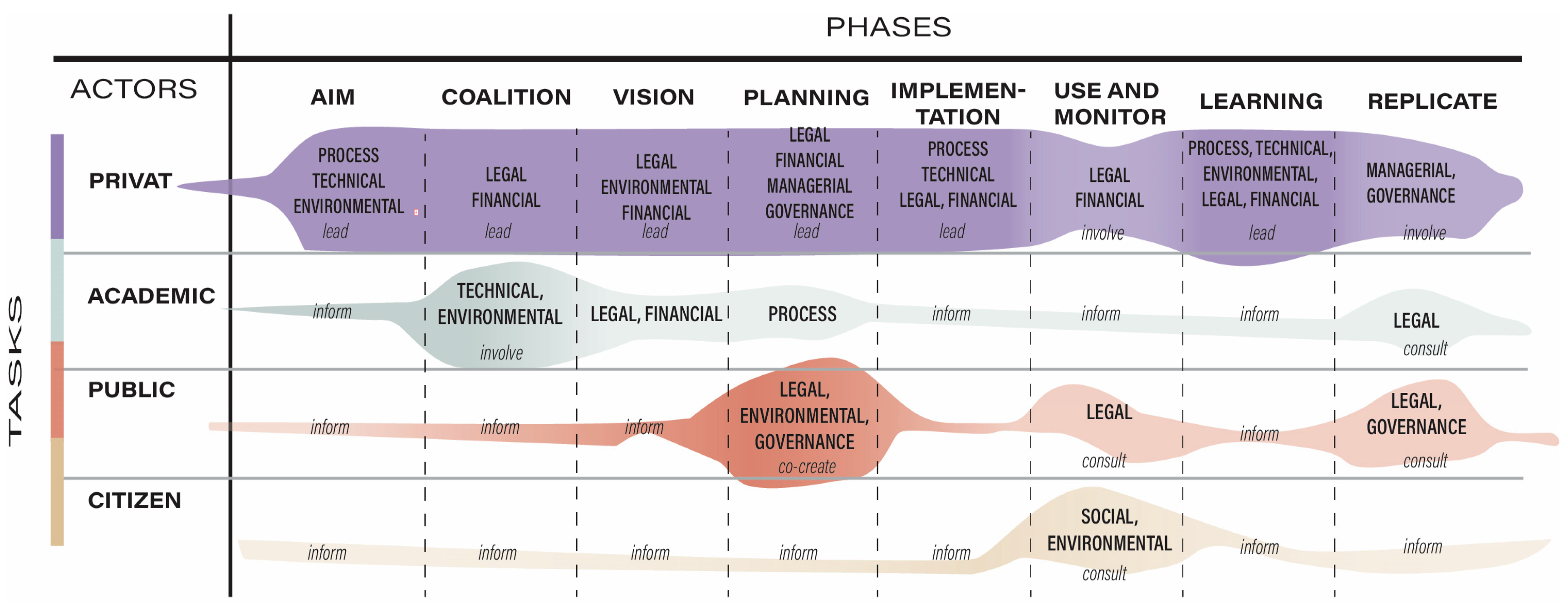
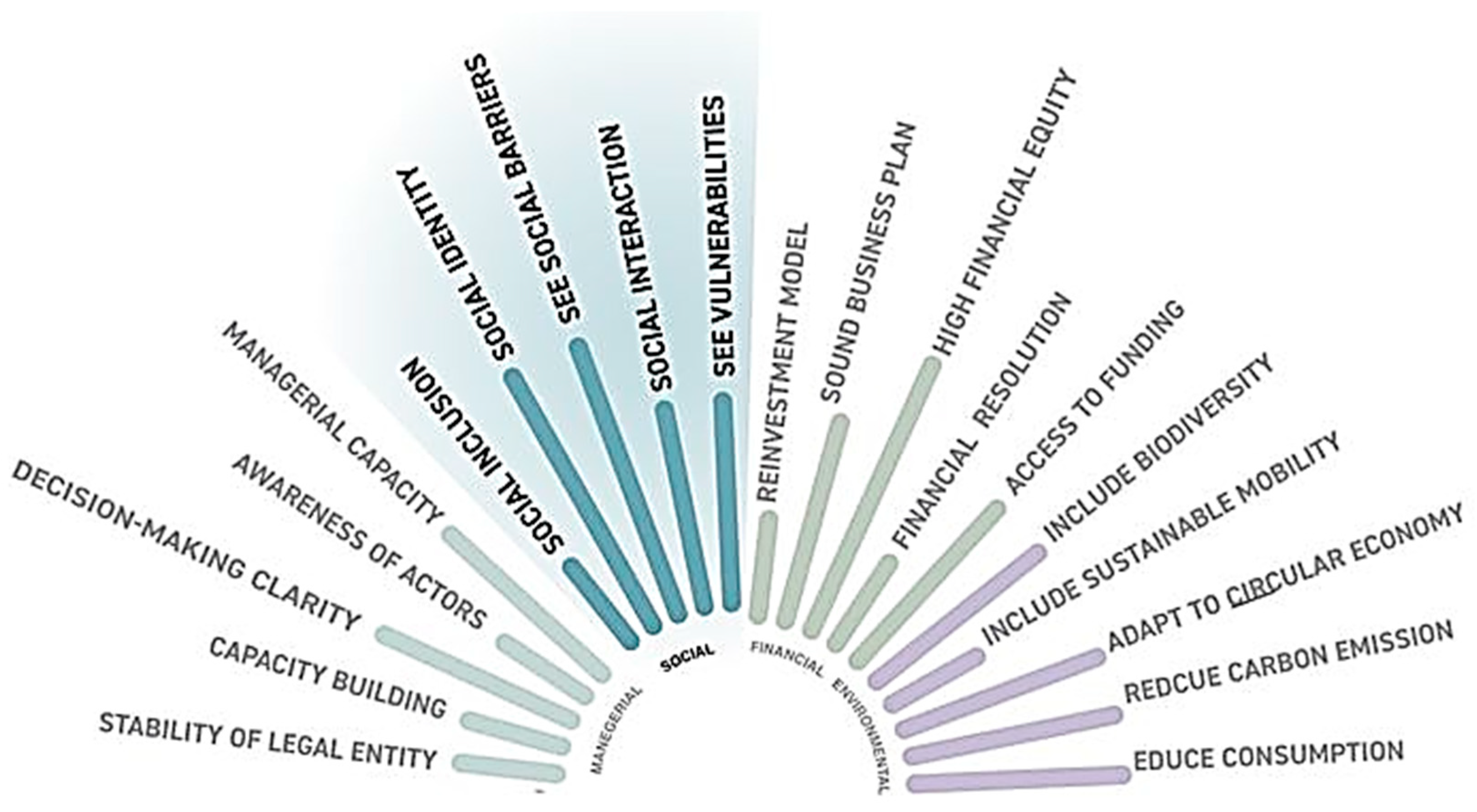

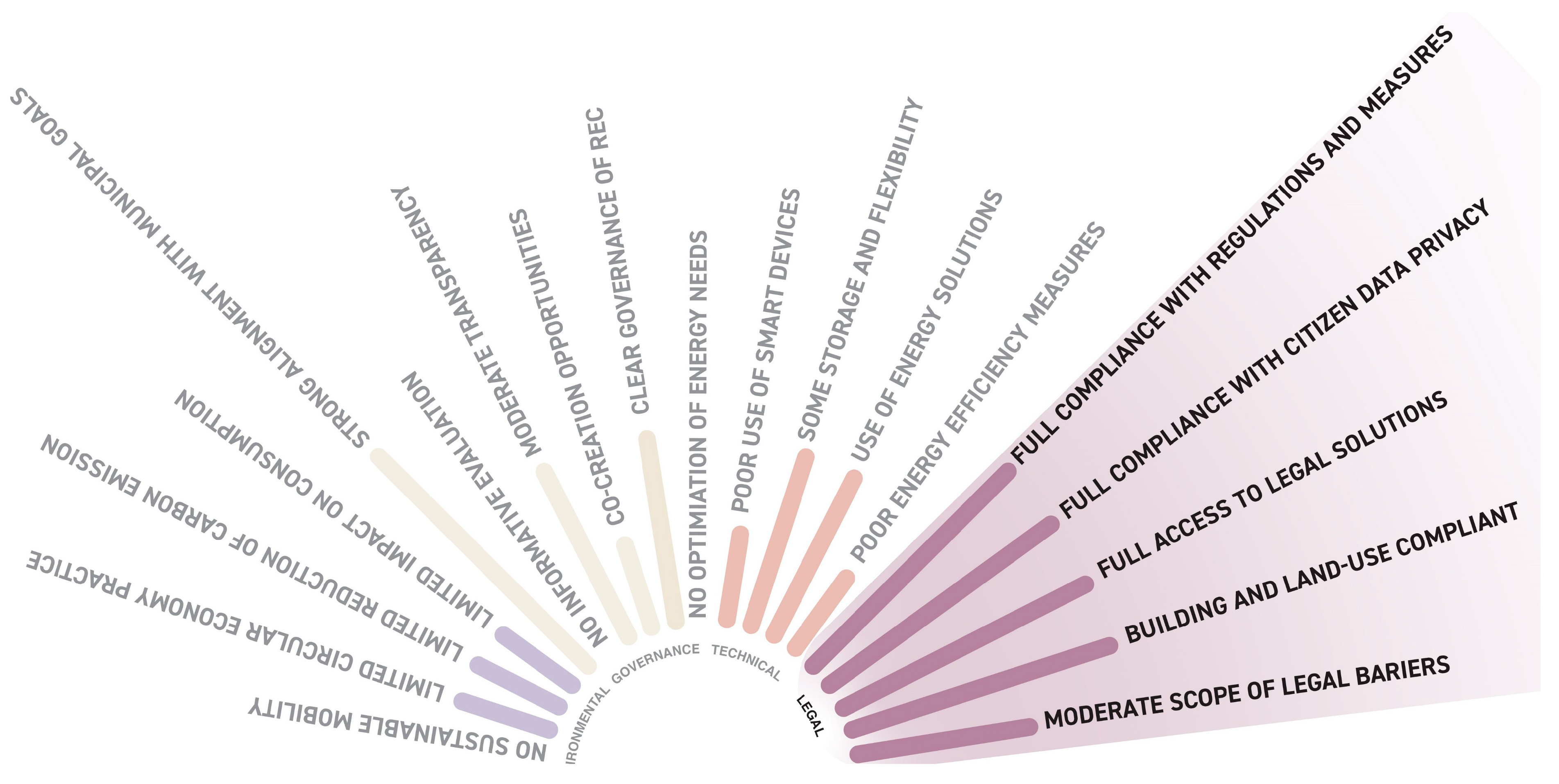
| Aspect | Early/Community Engagement Solutions | Dual-Tier Framework |
|---|---|---|
| Timing | Initiated at project’s beginning [20,21,22,26] | Structured across the entire lifecycle of a project |
| Stakeholder Role | Co-creation, empowerment, flexible roles [20,22,24,25] | Defined roles, mapped interactions |
| Adaptability | Highly context-sensitive, iterative [19,23,26] | Systematic, but can be adapted via ToC model |
| Evaluation | Feedback loops, participatory assessment [19,23,26] | Outcome-driven, explicit causal pathways |
| Communication | Diverse, culturally relevant, ongoing [21,22,24] | Structured, roadmap-based |
| Integration | Focus on local ownership and interconnected social elements [19,20,25] | Emphasizes alignment and interdisciplinary work |
| Attribute | GUIDING QUESTIONS |
|---|---|
| 1—Actor | Who are the individuals within actor categories? |
| 2—Agenda | Which mandates, missions, and objectives do they have? |
| 3—Arena | Where does the actor operate and what is their scope? |
| 4—Alliances | Which relationships exist with other actors? |
| 5—Role in PED | Which potential role can the actor play? |
| 6—Limitations | Which constraints, challenges, and capacities do they have? |
| Five Key Questions | |
|---|---|
| 1—Who | Potential counterparts and engagement priorities |
| 2—Why | Motivations for participation and collaboration needs |
| 3—What | What types of influence and engagement constellations are required? |
| 4—Which | Which engagement structures and frameworks are appropriate? |
| 5—How | Participation methods and organizational approaches |
| 6—Limitations | What constraints, challenges, and capacities exist? |
| Roadmap applications | |
| Bottom-up Roadmaps | Citizen-led initiatives evolving from energy communities to comprehensive PED development |
| Top-down Roadmaps | Municipal or policy-driven projects requiring community integration |
| Technical Roadmaps | Expert-led innovation projects needing social acceptance |
| Hybrid Roadmaps | Combined and linked approaches adapting to local circumstances and project evolution |
| Bottom-Up | Top-Down | Private Sector | |
|---|---|---|---|
| Location | Rural area in Austria | A midsized city, Sweden | An urban metropolitan area, Spain |
| Period of interaction and collaboration | 2021–2025 | 2022–2025 | 2024–2025 |
| Data types | focused interview, baseline study, PED modeling, PED Matrix self-assessment, PED case book, business canvas, co-creation reports | baseline study, PED modeling, PED Matrix self-assessment, PED case book, business canvas, co-creation reports | focused interview, baseline study, PED modeling, PED Matrix self-assessment, PED case book, business canvas, social programming |
| Participants | Citizens in REC board and members (prosumer, producer, consumer, multiplier members) | University researcher, municipal teams, energy sector teams, (municipal) housing company | Industrial actors in REC board, university researcher, municipal teams |
| Built environment | Mainly single-family homes, some multi-family homes, very limited mix of uses | Multi-family homes, housing only | Industrial area of the municipality |
| Speciality | The local authorities are not collaborating with the REC. The boundaries of the community reach multiple municipalities. The REC as an association performs social, cultural, and environmental activities for the community mainly as voluntary contributions | The residents of the buildings impacted (in rent) are not included in the development or upgrade to PED of the housing complex. The city has a CCC (Climate City Contract) | The REC started as an initiative of the businesses but is nowadays in close collaboration with the municipality. They have a business concept addressing private households but do not yet reach the citizens |
Disclaimer/Publisher’s Note: The statements, opinions and data contained in all publications are solely those of the individual author(s) and contributor(s) and not of MDPI and/or the editor(s). MDPI and/or the editor(s) disclaim responsibility for any injury to people or property resulting from any ideas, methods, instructions or products referred to in the content. |
© 2025 by the authors. Licensee MDPI, Basel, Switzerland. This article is an open access article distributed under the terms and conditions of the Creative Commons Attribution (CC BY) license (https://creativecommons.org/licenses/by/4.0/).
Share and Cite
Nasya, B.; Vurucu, Y.; Nedkova, D.; Shen, J.; Zhang, X. Operationalizing Community Engagement for Positive Energy Districts: A Dual-Tier Framework and Case-Validated Roadmaps. Urban Sci. 2025, 9, 495. https://doi.org/10.3390/urbansci9120495
Nasya B, Vurucu Y, Nedkova D, Shen J, Zhang X. Operationalizing Community Engagement for Positive Energy Districts: A Dual-Tier Framework and Case-Validated Roadmaps. Urban Science. 2025; 9(12):495. https://doi.org/10.3390/urbansci9120495
Chicago/Turabian StyleNasya, Bahanur, Yilmaz Vurucu, Danny Nedkova, Jingchun Shen, and Xingxing Zhang. 2025. "Operationalizing Community Engagement for Positive Energy Districts: A Dual-Tier Framework and Case-Validated Roadmaps" Urban Science 9, no. 12: 495. https://doi.org/10.3390/urbansci9120495
APA StyleNasya, B., Vurucu, Y., Nedkova, D., Shen, J., & Zhang, X. (2025). Operationalizing Community Engagement for Positive Energy Districts: A Dual-Tier Framework and Case-Validated Roadmaps. Urban Science, 9(12), 495. https://doi.org/10.3390/urbansci9120495






